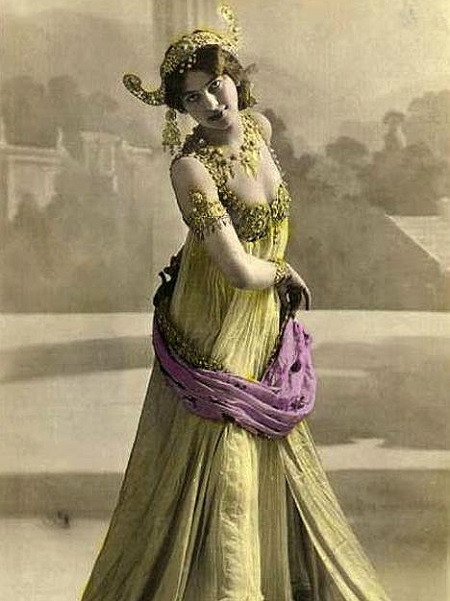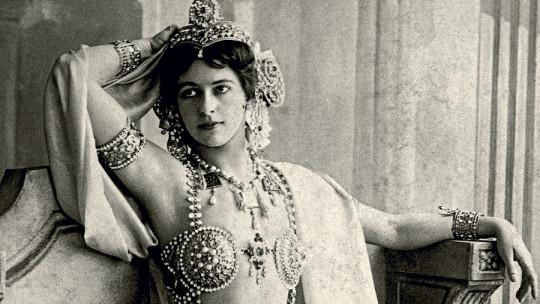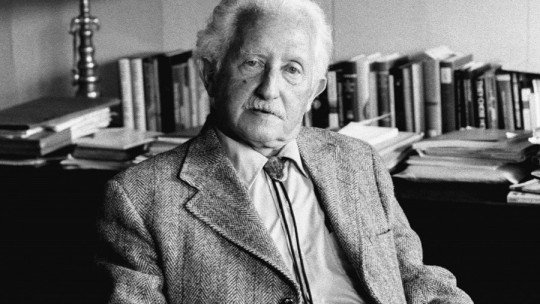He called himself Mata-Hari, “the eye of the day” in the Malay language But, although it is true that the exotic island of Java (present-day Indonesia) was the scene of her early youth, Mata-Hari was not a native of the place. She was a young Dutch girl who had married early, quickly and badly with a soldier assigned to the island. And it was there, on the hot Javanese nights, where the girl became a dancer.
She used her eroticism on stage and off to attract men, especially military men, for whom she had an obvious fascination. Mata-Hari was a luxurious courtesan, but was she also a spy?
Some current studies call this appellation into question, since the charges that brought her to trial for espionage and that, ultimately, placed her before the firing squad, are confusing and contradictory. So let’s see what really happened.
Brief biography of Mata-Hari
Who was Mata-Hari? What was his real name? Why has she gone down in history as one of the most famous spies, when in reality the information he was able to pass on was scarce and of little importance? In this article we will try to unravel all the mysteries that concern the “eye of the day”, the beautiful Javanese dancer.
Aim for the highest
Mata-Hari’s real name was Margaretha Geertruida Zelle, and she was born in 1876 in Leewarden, Netherlands His father, Adam Zelle, was a rather modest hat maker, but he possessed delusions of grandeur and high expectations for his little girl. They say that Mr. Zelle, on her first day of school, made the girl enter a cart pulled by little goats. Of course, Margaretha’s future companions laughed heartily, but Mr. Zelle had already achieved what he wanted: for the name of his daughter to be on everyone’s lips.
In truth, there was no need for Zelle to contribute to her daughter’s fame, since Margaretha had a natural magnetism that made her stand out wherever she went. As she entered adolescence, Margaretha’s beauty began to attract her attention. Tall, with sinuous shapes, with thick raven hair and large black eyes, the young girl was desired by everyone. Even by the principal of her school. It is not known for sure if Margaretha encouraged her relationship or if, on the contrary, the man harassed her relentlessly; But the fact is that the young woman was expelled surrounded by insults and controversy.
The exotic island of Java
That was her first scandal involving a man. Many more would follow. However, before becoming the courtesan we all know, Margaretha got married.
In 1895, and possibly eager to escape her family (her mother had died and her father had remarried), Margaretha responds to a newspaper advertisement, in which a certain Rudolf MacLeod, a 39-year-old soldier, is looking for a wife to take with him to the island of Java , where he has been assigned. After a brief exchange of letters, where they say that Margaretha introduced a photograph of herself to be more “convincing,” the two married in Amsterdam on July 11, 1895. Margaretha is 19 years old.
Marriage and, above all, the move to Indonesia will be crucial in the young woman’s life. Because it is there, on Javanese nights, where Margaretha learns the traditional dances and, especially, the love rituals of the natives, which will serve him so well for her future conquests. Perhaps, in fact, the only thing the Dutch woman wanted was to shake off the pain that the death of her little son Norman-John had caused her. In 1899, her two sons became seriously ill.
Only the girl was saved. A death shrouded in a thick veil of mystery about which nothing is still known today. Had Margaretha infected her children with the syphilis that her husband had previously passed on to her? Or was the bizarre story that spread by word of mouth true, that a native servant had poisoned the children in revenge for the ill-treatment her husband had received at the hands of MacLeod?
Mata-Hari is born
The death of little Norman-John aggravates Rudolf’s alcoholism and drives a deep chasm between the couple. When they return to the Netherlands in 1903, they are already legally separated; The divorce is ratified a few years later.
Rudolf had kept custody of Louise Jeanne, the surviving daughter, so he did not send any pension to his ex-wife. Margaretha’s situation was truly dramatic; Driven by necessity (and not by lust as her detractors maintained), she was forced to sell her body. Thus, she begins to pose for erotic photographs and sleeps with important people who pay for her an increasingly luxurious existence. Because yes, it seems that Margaretha, the true daughter of her father, I had very high aspirations
Her splendid dark beauty and her knowledge of Javanese dances inspire her with the definitive idea: she will pose as Mata-Hari, an enigmatic and beautiful princess from the island of Java, motherless and educated, according to the biography she herself invented, in a Hindu temple, from which he collected his sensual dances and his exotic secrets.

Nowadays it seems incredible to us that the public would believe such nonsense, but we have to understand that, At the end of the 19th century, the East held an almost morbid fascination among Europeans Even more; The extraordinary repression of the Victorian era meant that any display of a naked or almost naked body was, at the same time, scandal and success. What difference did it make if the young woman who danced covered in transparent fabrics, writhing “lewdly,” was Javanese or not. She would accept anything as long as it released, for a few moments, her corseted and pressing libido.
Touching the sky with your hands
Success came to Margaretha relatively late; She was almost 30 years old when she first danced before the public with her new identity. It was March 13, 1905; the setting, the Guimet Museum, owned by Émile Étienne Guimet. Since then, Her fame as an exotic dancer only grew
The performances of the supposed Javanese princess satisfied the repressed sexual appetite of fin-de-siècle society. Abrupt hip movements, impossible positions and, above all, thin gauze that subtly covered her body, which Mata-Hari got rid of as the dance progressed.
They say that she was completely naked, although others claim that a leotard of the same color as her skin covered her body. What is certain is that Margaretha always refused to show her breasts, which she covered with a kind of precious stone bra; It is not clear if it was because of her complex (she had them very small) or because of the supposed scar that her husband had left in a fit of anger.
Little by little, in addition to the performance halls and private rooms, the rooms of the big shots of society were being opened for Mata-Hari The Dutch woman began to lead an exorbitant lifestyle, financed by her increasingly numerous and powerful lovers.
Playing spy
The greatest misfortune in Margaretha’s life was probably the outbreak of the First World War Among Mata-Hari’s (long) list of lovers were soldiers of various nationalities, which could be a real setback for his security.
From here, the information we have about Margaretha twists and delves into recesses where truth, legend and lies mix. It has been said that she became a spy for France just to have the guarantee of getting close to the battle front to see what she believed was the great love of her life, the Russian pilot Vadim Maslov, who served in the French forces. According to these sources, among which are the historians Norman Polmer and Thomas Allen, the Deuxième Bureau, that is, the French secret service, guaranteed that he could visit her lover in the field hospital if she agreed to pass on information to them.
Apparently, When France hired Mata-Hari as a spy, she was already working for German enemies, meaning that, for a time, she was a double agent It seems that, during his stay in Madrid (capital of a neutral Spain, where spies of all nationalities swarmed), Mata-Hari held conversations with the German military attaché, Arnold Kalle, a fact that was used in his subsequent trial to prove that he had passed French information to the Germans. This has never been verified, and it may even be that Mata-Hari’s meetings with Kalle were strictly to extract useful information for France.
A notorious (and irregular) trial
In early 1917, the French captured an encrypted German message through their radio station located at the top of the Eiffel Tower. In the message, Kalle talks about the spy H-21, who would be working for Germany. All the characteristics match Mata-Hari, so the French secret services have no doubt: Margaretha is playing both sides.
On February 13, the dancer is arrested in her room at the Elysee Palace hotel in Paris, on charges of espionage for the enemy It seems that, to support the accusation, the people who searched the room declared that they had found substances that allowed the manufacture of invisible ink. However, everything indicates that these substances were nothing other than the mercury that Mata-Hari used to treat the ulcers that syphilis had left on him.
The trial was full of irregularities. The evidence presented was inconclusive, and she declared at all times to have remained faithful to France. Famous is the phrase that they say she shouted during the session: “Whore? Yes. Traitor? Never!”. On the other hand, her defense lawyer had no experience in military trials and gave a poor intervention. Mata-Hari was doomed in advance.
The sentence was capital punishment by firing squad, which was ratified at dawn on October 15, 1917 Mata-Hari appeared neatly and elegantly dressed, and eyewitnesses claim that, before falling under the bullets, she blew a kiss to the platoon.
Was Mata-Hari really a spy? Possibly she did pass certain information to the French, information that all sources indicate was of little or no importance to the development of the war. However, It is not proven that Mata-Hari worked for Germany If so, everything would have been a ruse concocted by the Germans to get her off their backs. Supporting this theory is the fact that, when they sent the telegram, the Germans knew perfectly well that the French had decrypted their code for months, so it was evident that the supposedly “encrypted” message would be read by the enemy. Did they send it on purpose?
But if so, why did they want Mata-Hari to disappear? Some theories even suggest that the message in question was doctored by the French secret service itself, commanded by a certain George Ladoux… and that the trial and subsequent execution of Mata-Hari would have simply served as a maneuver to raise the morale of the jaded French.
Be that as it may, Margaretha Geertrudia Zelle has gone down in history as a true femme fatale and a talented spy. And probably neither of those things are true. Or, at least, not completely.









